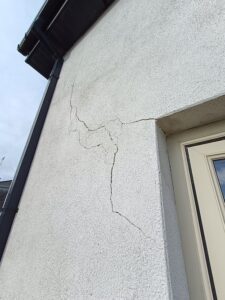What causes subsidence in your home?
Few things are more stressful for a homeowner than discovering cracks in your walls and suspecting that your home may be suffering from subsidence. The good news is, you’ve come to the right place. At Geobear, we’re experts in understanding the causes of subsidence and, more importantly, in providing fast, effective, and non-disruptive solutions to give you back your peace of mind.
We know how much your home means to you. It’s your most valuable asset, and we treat it with the same respect we do our own. We’ll talk you through the process in plain, simple language, so you understand exactly what’s happening and what we can do to help.
 Natural causes of ground subsidence
Natural causes of ground subsidence
Sometimes, the ground beneath our homes can move due to natural processes. This is often referred to as natural ground subsidence or natural subsidence. Here are some of the most common reasons why this might happen:
-
Shrink-swell of clay soils: Many homes in the UK are built on clay soil. During long periods of dry weather, the clay can shrink as the water content reduces. This is a major cause of what is known as shrink swell subsidence. When the rains return, the ground swells back up. This constant movement can put a huge strain on your home’s foundations.
-
Trees and other vegetation: Large trees, especially oak, willow, and poplars, drink a lot of water from the soil. A large tree can absorb up to 50,000 litres of water from the ground in a year. When they are close to your home, they can dry out the soil and cause the ground to shrink.
-
Washing away of soils: In areas with sandy or gravelly soils, water from a leaking drain or a natural spring can wash the soil away from under your foundations. This can create a void, leading to ground subsidence.
-
Decomposition of soils: Some soils, like peat, are naturally less stable and can break down and compact over time, causing the ground level to drop. This is another form of land subsidence.
Man-made causes of subsidence
It’s not just nature that can cause problems. Here are some of the man-made subsidence causes that we often see:
-
Leaking drains and water pipes: This is one of the most common causes of subsidence. A slow, steady leak from a damaged drain can soften the ground or wash it away over time, weakening the support for your home’s foundations.
-
Made ground: If your home was built on an area that was previously a quarry, a landfill, or just uneven ground that has been filled in, this “made ground” can be less stable than natural ground and can compact over time.
-
Nearby construction or traffic: The vibrations from heavy traffic or nearby construction work can cause the ground to shift and compact, which can lead to problems for your home.
How Geobear can help
Whatever the cause of your subsidence issue, we have a solution. We are the original inventors of expansive geopolymer injection systems, with 40 years of research and development behind us. Our in-house team of geotechnical, civil, and structural engineering experts will diagnose the problem and create a bespoke treatment plan for your home.
The Geobear solution is a non-disruptive alternative to traditional methods like underpinning. We inject a specialist material into the ground, which expands to fill any voids and improve the ground’s load-bearing capacity. The process is quick, clean, and you won’t even have to move out of your home while we work.
We understand the stress and uncertainty that comes with subsidence. That’s why we’re committed to providing clear, honest advice and a reliable, long-term solution. Our work is backed by a 10-year, insurance-backed guarantee for your complete peace of mind.
If you’re worried about subsidence, don’t hesitate to get in touch. We’re here to help you get your home back on solid ground.
 Natural causes of ground subsidence
Natural causes of ground subsidence